| Entry | Database: PDB / ID: 2lf4
|
|---|
| Title | Structure of a monomeric mutant of the HIV-1 capsid protein |
|---|
 Components Components | Gag polyprotein |
|---|
 Keywords Keywords | PROTEIN TRANSPORT / fullerene |
|---|
| Function / homology |  Function and homology information Function and homology information
viral budding via host ESCRT complex / HIV-1 retropepsin / symbiont-mediated activation of host apoptosis / retroviral ribonuclease H / exoribonuclease H / exoribonuclease H activity / DNA integration / viral genome integration into host DNA / RNA-directed DNA polymerase / establishment of integrated proviral latency ...viral budding via host ESCRT complex / HIV-1 retropepsin / symbiont-mediated activation of host apoptosis / retroviral ribonuclease H / exoribonuclease H / exoribonuclease H activity / DNA integration / viral genome integration into host DNA / RNA-directed DNA polymerase / establishment of integrated proviral latency / RNA stem-loop binding / viral penetration into host nucleus / host multivesicular body / RNA-directed DNA polymerase activity / RNA-DNA hybrid ribonuclease activity / Transferases; Transferring phosphorus-containing groups; Nucleotidyltransferases / host cell / viral nucleocapsid / DNA recombination / DNA-directed DNA polymerase / Hydrolases; Acting on ester bonds / aspartic-type endopeptidase activity / DNA-directed DNA polymerase activity / symbiont-mediated suppression of host gene expression / viral translational frameshifting / lipid binding / symbiont entry into host cell / host cell nucleus / host cell plasma membrane / virion membrane / structural molecule activity / proteolysis / DNA binding / RNA binding / zinc ion binding / membraneSimilarity search - Function Retrovirus capsid C-terminal domain / Human Immunodeficiency Virus Type 1 Capsid Protein / Human Immunodeficiency Virus Type 1 Capsid Protein / Gag protein p6 / Gag protein p6 / Non-ribosomal Peptide Synthetase Peptidyl Carrier Protein; Chain A / : / gag protein p24 N-terminal domain / Reverse transcriptase connection / Reverse transcriptase connection domain ...Retrovirus capsid C-terminal domain / Human Immunodeficiency Virus Type 1 Capsid Protein / Human Immunodeficiency Virus Type 1 Capsid Protein / Gag protein p6 / Gag protein p6 / Non-ribosomal Peptide Synthetase Peptidyl Carrier Protein; Chain A / : / gag protein p24 N-terminal domain / Reverse transcriptase connection / Reverse transcriptase connection domain / Reverse transcriptase thumb / Reverse transcriptase thumb domain / Integrase Zinc binding domain / Zinc finger integrase-type profile. / Integrase-like, N-terminal / Integrase DNA binding domain / Integrase, C-terminal domain superfamily, retroviral / Integrase, N-terminal zinc-binding domain / Integrase, C-terminal, retroviral / Integrase DNA binding domain profile. / Immunodeficiency lentiviral matrix, N-terminal / gag gene protein p17 (matrix protein) / RNase H / Integrase core domain / Integrase, catalytic core / Integrase catalytic domain profile. / Retropepsin-like catalytic domain / Matrix protein, lentiviral and alpha-retroviral, N-terminal / Retroviral nucleocapsid Gag protein p24, C-terminal domain / Gag protein p24 C-terminal domain / RNase H type-1 domain profile. / Ribonuclease H domain / Retropepsins / Retroviral aspartyl protease / Aspartyl protease, retroviral-type family profile. / Peptidase A2A, retrovirus, catalytic / Retrovirus capsid, C-terminal / Reverse transcriptase domain / Reverse transcriptase (RNA-dependent DNA polymerase) / Reverse transcriptase (RT) catalytic domain profile. / Retroviral matrix protein / Retrovirus capsid, N-terminal / zinc finger / Zinc knuckle / Zinc finger, CCHC-type superfamily / Zinc finger, CCHC-type / Zinc finger CCHC-type profile. / Aspartic peptidase, active site / Eukaryotic and viral aspartyl proteases active site. / Aspartic peptidase domain superfamily / Ribonuclease H superfamily / Ribonuclease H-like superfamily / Reverse transcriptase/Diguanylate cyclase domain / DNA/RNA polymerase superfamily / Orthogonal Bundle / Mainly AlphaSimilarity search - Domain/homology |
|---|
| Biological species |   Human immunodeficiency virus 1 Human immunodeficiency virus 1 |
|---|
| Method | SOLUTION NMR / simulated annealing |
|---|
| Model details | closest to the average, model 4 |
|---|
 Authors Authors | Shin, R.S. / Tzou, Y. / Krishna, N. |
|---|
 Citation Citation |  Journal: Biochemistry / Year: 2011 Journal: Biochemistry / Year: 2011
Title: Structure of a Monomeric Mutant of the HIV-1 Capsid Protein.
Authors: Shin, R. / Tzou, Y.M. / Krishna, N.R. |
|---|
| History | | Deposition | Jun 28, 2011 | Deposition site: BMRB / Processing site: RCSB |
|---|
| Revision 1.0 | Nov 9, 2011 | Provider: repository / Type: Initial release |
|---|
| Revision 1.1 | Jun 14, 2023 | Group: Data collection / Database references / Other
Category: database_2 / pdbx_database_status ...database_2 / pdbx_database_status / pdbx_nmr_software / pdbx_nmr_spectrometer / struct_ref_seq_dif
Item: _database_2.pdbx_DOI / _database_2.pdbx_database_accession ..._database_2.pdbx_DOI / _database_2.pdbx_database_accession / _pdbx_database_status.status_code_nmr_data / _pdbx_nmr_software.name / _pdbx_nmr_spectrometer.model / _struct_ref_seq_dif.details |
|---|
| Revision 1.2 | May 15, 2024 | Group: Data collection / Database references / Category: chem_comp_atom / chem_comp_bond / database_2 / Item: _database_2.pdbx_DOI |
|---|
|
|---|
 Open data
Open data Basic information
Basic information Components
Components Keywords
Keywords Function and homology information
Function and homology information
 Human immunodeficiency virus 1
Human immunodeficiency virus 1 Authors
Authors Citation
Citation Journal: Biochemistry / Year: 2011
Journal: Biochemistry / Year: 2011 Structure visualization
Structure visualization Molmil
Molmil Jmol/JSmol
Jmol/JSmol Downloads & links
Downloads & links Download
Download 2lf4.cif.gz
2lf4.cif.gz PDBx/mmCIF format
PDBx/mmCIF format pdb2lf4.ent.gz
pdb2lf4.ent.gz PDB format
PDB format 2lf4.json.gz
2lf4.json.gz PDBx/mmJSON format
PDBx/mmJSON format Other downloads
Other downloads 2lf4_validation.pdf.gz
2lf4_validation.pdf.gz wwPDB validaton report
wwPDB validaton report 2lf4_full_validation.pdf.gz
2lf4_full_validation.pdf.gz 2lf4_validation.xml.gz
2lf4_validation.xml.gz 2lf4_validation.cif.gz
2lf4_validation.cif.gz https://data.pdbj.org/pub/pdb/validation_reports/lf/2lf4
https://data.pdbj.org/pub/pdb/validation_reports/lf/2lf4 ftp://data.pdbj.org/pub/pdb/validation_reports/lf/2lf4
ftp://data.pdbj.org/pub/pdb/validation_reports/lf/2lf4
 Links
Links Assembly
Assembly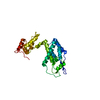
 Components
Components
 Human immunodeficiency virus 1 / Gene: gag / Production host:
Human immunodeficiency virus 1 / Gene: gag / Production host: 
 Sample preparation
Sample preparation Movie
Movie Controller
Controller



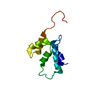
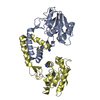

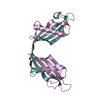

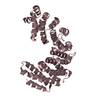




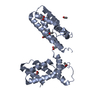
 PDBj
PDBj

 HSQC
HSQC